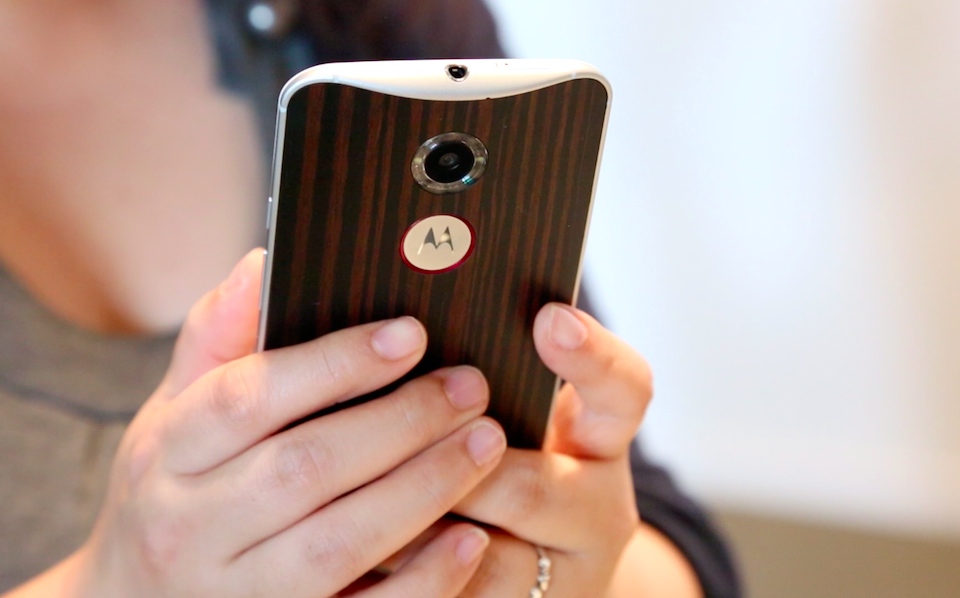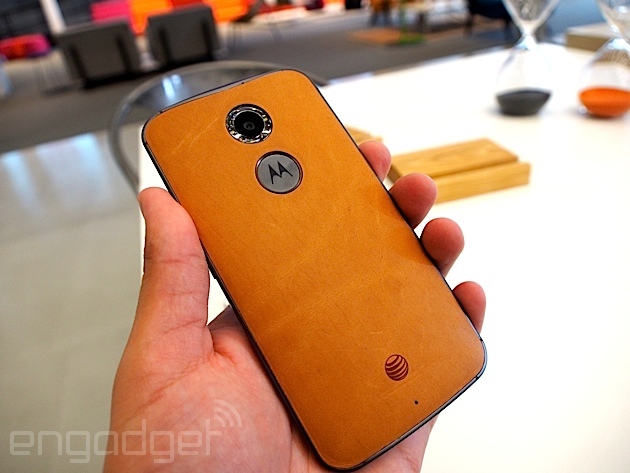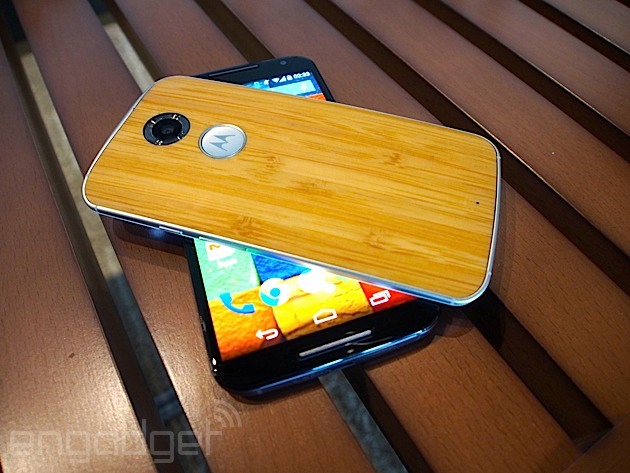
As a half dozen of my colleagues toil away in Berlin bringing you the latest news from the likes of Samsung and Sony, I'm more than 4,000 miles away in the city of Chicago. Specifically, I'm in Motorola's headquarters, which spans 600,000 square feet across four floors high atop the Merchandise Mart, a large and impressive commercial building built in 1931. After taking a grand tour through its facilities, I finally encounter Motorola's latest flagship smartphone: the Moto X.
No, not last year's Moto X. I mean the new Moto X, the one that it's announcing today to the world. Yes, the company -- which Lenovo has recently agreed to purchase -- has decided to keep the name the same. But aside from the name, the new Moto X promises to be different. It's bigger, beefier and it boasts a number of new features and design tweaks that should up the X's desirability quotient considerably. All of that, and the new Moto X is priced to please: It starts at only $99.99 on-contract and $499.99 (£419.99) unlocked.
Now let's dive into the details, starting with that screen. To be honest, it's not that much bigger than the old one; the 5.2-inch AMOLED display, still in Corning Gorilla Glass, is only roughly half an inch wider than last year's X. But now it sports a 1080p display instead of a 720p one, which makes it a touch more pleasing to the eye. The screen takes up almost the entirety of the phone's face, leaving just a bit of bezel on the bottom and the top, so it gives the illusion of a much larger display. To make room for the larger screen, the phone itself is also just a hair bigger -- it measures 72.4mm wide by 140.8mm tall and it weighs about 144 grams. The new Moto X retains the curved back from the original, but with a slightly slimmer width -- arching from 3.8mm at its thinnest to 9.9mm -- that still cradles nicely in the hand.
While we had no real complaints about the build quality of the original Moto X, the company wanted its latest iteration to feel more premium than before. That's why instead of a plastic frame, the new Moto X has a smooth piece of aluminum wrapping the entire edge of the phone -- it's thin around the corners and fattens up as it approaches the middle. That also happens to be where the external antenna is housed. If you're concerned about antenna issues -- like, uh, that certain other phone from that company in Cupertino -- Motorola assures us that due to an advanced "Dynamic Tuning" technology that knows how to compensate for your grip, there is no wrong way to hold the phone.
To pile on the premium factor, Motorola has not only kept the Moto Maker customization option alive, but it's also introduced a new leather option into the family. Yep, if a wood back isn't fancy enough for you, you can now get a Moto X back made with one of four different leathers: Natural, Cognac, Black and Navy. And it's not just some cheap pleather knock-off either; that leather is sourced from The Horween Leather Company, a well-known Chicago tannery that's also providing the material for the Moto 360's strap. Additionally, Moto Maker also now lets you add metal accents to power and volume buttons, speaker grilles and the Motorola logo on the back. That logo, incidentally, is ever so slightly recessed, creating a dimple effect.
Above that logo is an updated 13-megapixel camera (it was a 10-megapixel unit on the old one) with 4x zoom and a ring flash, which Motorola says will result in softer lighting. We'll need some time to test the camera a little more, but right now we know that it can capture 4K video instead of just 1080p and it's also got a new feature called Best Shot. It essentially maintains a rolling photo cache in the background, constantly capturing additional shots before and after a photo is taken. An algorithm then analyzes those photos to find what it thinks is the "best shot," filtering out blurry shots or pics of people blinking. You're then free to choose the selected shot or opt for your original image instead. Another new camera feature is the "Highlight Reel," which essentially compiles all of your day's photos and videos into a single video collage.

As far as other hardware specs go, the new Moto X touts a Qualcomm Snapdragon 801 processor with a 2.5GHz quad-core CPU, a 578MHz Adreno 330 GPU and 2GB of RAM. It also houses a 2,300mAh battery, which Motorola claims will last a full day. The new Moto X has four microphones to help reduce background noise, comes in a "splash guard" water-repellent coating (though it likely won't survive a dunk in the pool) and will be available in both 16GB and 32GB iterations.
Now on to the software. Android purists will be glad to know that the new Moto X will come with "pure Android" just as before -- this means that the phone is mostly stock (like the home screen and the icons), but it does have a few additions that Motorola has built in. But that's not necessarily a bad thing. For one thing, Motorola's Migration tool makes it easier to port over old contacts over to your new phone. But what really makes it a Motorola phone are the additions it introduced in the original X, such as Touchless Control, Active Display and Motorola Assist. Those have been renamed in the new Moto X as Moto Actions, Moto Display and Moto Assist, which we'll get to below.
What really makes the new Moto X different from the old though, is that instead of just saying "OK Google" as a voice prompt, you can now say, well, whatever you damn well like. Yep, you can now customize that voice command prompt to anything you fancy. Now, there are a few restrictions -- you can't have anything with too few syllables or anything that's too common of a phrase (So "Hi there" and "Yo bitch" aren't ideal). But go ahead and use phrases like "OK Moto X" or "Wake up sleepyhead," or our personal favorite, "Hello Jarvis."
Now on to the software. Android purists will be glad to know that the new Moto X will come with "pure Android" just as before -- this means that the phone is mostly stock (like the home screen and the icons), but it does have a few additions that Motorola has built in. But that's not necessarily a bad thing. For one thing, Motorola's Migration tool makes it easier to port over old contacts over to your new phone. But what really makes it a Motorola phone are the additions it introduced in the original X, such as Touchless Control, Active Display and Motorola Assist. Those have been renamed in the new Moto X as Moto Actions, Moto Display and Moto Assist, which we'll get to below.
What really makes the new Moto X different from the old though, is that instead of just saying "OK Google" as a voice prompt, you can now say, well, whatever you damn well like. Yep, you can now customize that voice command prompt to anything you fancy. Now, there are a few restrictions -- you can't have anything with too few syllables or anything that's too common of a phrase (So "Hi there" and "Yo bitch" aren't ideal). But go ahead and use phrases like "OK Moto X" or "Wake up sleepyhead," or our personal favorite, "Hello Jarvis."

Additionally, Moto Voice comes with a few custom phrases, like "Take a selfie," which activates the front-facing camera along with a countdown timer so you never have to press a button. Other phrases include "Good morning" to shut off Sleep Mode and tell you about your first appointment, "What's Up" to inform you of the time and the latest notifications. There's also "Navigate" followed by the name of a destination. You can also say "Play YouTube" to launch YouTube and "Post to Facebook" to update your Facebook status. It seems that Moto Voice only works with a handful of apps right now (Facebook, YouTube and WhatsApp are supported so far), though we expect (and hope) more will come later on.
Moto Actions have also been upgraded beyond just tapping and swiping the screen. The new Moto X is equipped with four IR sensors on the front, which are there specifically to detect gestures and movement. Alarm going off, but not ready to get up? Simply wave your hand over to snooze it. Incoming call from that annoying neighbor? Do the same to silence it. You can also wave your hand to simply wake the phone up from sleep, which will prompt Moto Display by default. This lets you see the time and up to three notifications -- press and hold down on one to get a quick peek at what the notification is about. For more on what Moto Display/Active Display is about, read our previous review of the old Moto X.
And, as we said earlier, you can get the new Moto X for only $99.99 on-contract or $499.99 (£419.99) if you decide to get an unlocked one. That's remarkably affordable for what is ostensibly a flagship phone from a major manufacturer. Right now, it appears that the US carriers will likely be AT&T and Verizon. As for availability, the Moto X will be out later this month in countries across North America, Latin America, Europe and Asia.
Moto Actions have also been upgraded beyond just tapping and swiping the screen. The new Moto X is equipped with four IR sensors on the front, which are there specifically to detect gestures and movement. Alarm going off, but not ready to get up? Simply wave your hand over to snooze it. Incoming call from that annoying neighbor? Do the same to silence it. You can also wave your hand to simply wake the phone up from sleep, which will prompt Moto Display by default. This lets you see the time and up to three notifications -- press and hold down on one to get a quick peek at what the notification is about. For more on what Moto Display/Active Display is about, read our previous review of the old Moto X.
And, as we said earlier, you can get the new Moto X for only $99.99 on-contract or $499.99 (£419.99) if you decide to get an unlocked one. That's remarkably affordable for what is ostensibly a flagship phone from a major manufacturer. Right now, it appears that the US carriers will likely be AT&T and Verizon. As for availability, the Moto X will be out later this month in countries across North America, Latin America, Europe and Asia.


No comments:
Post a Comment